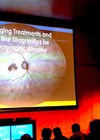Age-related macular degeneration (AMD) is one of the leading causes of irreversible blindness in the developing world with its prevalence rising alongside age. In societies characterised by ageing populations, it is imperative we explore more effective treatment to alleviate the growing disease burden. There is no effective treatment currently approved for dry AMD in the UK. The majority of novel treatments aim to manage geographic atrophy (GA), a late stage in the degenerative progression of AMD. This article delves into five innovative approaches for addressing dry AMD.
1. Pegcetacoplan (Syfovre)
The Food and Drug Administration (FDA) has approved Pegcetacoplan, the first ever drug for use in GA which is to be administered intravitreally. Pegcetacoplan functions as a complement C3 inhibitor, countering the hypothesised C3 activity in AMD through the complement alternative pathway.
Initial studies indicate lower rates of disease progression, specifically in incomplete retinal pigment epithelium (RPE) and outer retinal atrophy (iRORA), when compared to control groups (50% vs. 81.8%) [1].
Additionally, a phase 3 multicentre, randomised controlled study (OAKS) has showcased Pegcetacoplan’s capability to reduce GA growth rate by 22% and 18% over 24 months when receiving an intravitreal injection monthly or bi-monthly respectively [2]. Similarly, the DERBY study showed a 19% and 16% reduction in GA with monthly and bi-monthly injections.
2. Izervay / Zimura
In early 2023, Zimura, a drug presented to the FDA for approval, has successfully secured its place as the second treatment option for GA under the name Izervay. Unlike Pegcetacoplan, Zimura operates as a complement C5 inhibitor, targeting another crucial complement involved in the pathogenesis of AMD and effectively reducing the degeneration of retinal cells.
The company spearheading Zimura’s clinical trials, Iveric Bio, reported a “statistically significant reduction (27.4%) in the rate of GA progression at the 12-month primary endpoint across two phase 3 clinical trials” [3].
Notably, no adverse effects or inflammation directly attributed to Zimura were observed. The predominant ocular adverse effects were attributed to the intravitreal administration method.
3. Brimonidine drug delivery system
Brimonidine, an alpha-2 adrenergic receptor agonist primarily employed in glaucoma to alleviate intraocular pressure, has gained attention in AMD therapy owing to the widespread presence of alpha-2 adrenergic receptors in the neurosensory retina, intricately involved in vital signalling pathways. It is thought that interference of these receptors can reduce rate of degeneration, as well as increase resistance to injury, and ultimately prevent cell death.
However, the shift towards AMD treatment necessitates overcoming challenges associated with brimonidine’s short intravitreal half-life, limited to approximately 10 hours, making frequent injections impractical for sustained therapeutic levels.

To address this issue, a specialised drug delivery system in the form of an implant is under development. This innovative system is designed to gradually dispense brimonidine into the retina at predetermined intervals, ensuring the sustained therapeutic effect required for AMD treatment.
This promising approach is advancing into phase 3 trials, supported by prior studies that provided compelling “evidence of safety and efficacy” [4]. Encouragingly, recent research demonstrated a noteworthy 7% reduction in geographic atrophy over a span of 24 months [5].
Subsequent trials are poised to refine both dosage and delivery mechanisms, with the ultimate goal of optimising the reduction of GA in AMD patients.
4. Autologous stem cell therapy
Over the course of a decade, the National Institute of Health has made extensive efforts on the programming of patient-derived induced pluripotent stem (iPS) cells, which when differentiated into RPE cells, serve to replace those lost in dry AMD from degeneration. These programmed iPS cells are surgically implanted and currently, this clinical trial is under phase 1/2a to determine safety, following prevention of blindness in animal models.
Primary end points are centred around changes in visual acuity and occurrence of adverse events [6]. Stem cell therapy could revolutionise AMD treatment by providing an avenue to regenerate tissue and therefore prevent associated blindness.
With all stem cell therapy, an important consideration is the oncogenic transformation which must be monitored carefully in the clinical trials.
5. NT-501 implant therapy
NT-501 is an intraocular implant containing genetically modified cells that secrete ciliary neurotrophic factor (CNTF) which allows dosage to the retinal layers. CTNF has been shown to protect retinal cone and rod photoreceptors by supressing excessive formulation of visual pigments. Furthermore, it has been shown in animal models to increase thickness of the retina, in particular the outer nuclear layer of photoreceptors. The implant has reached a phase 2 trial and was deemed to be well-tolerated with no serious adverse effects attributed to the NT-501 implant and stabilised best corrected visual acuity (BCVA) better than control groups (96.3% vs. 75%) [7].
Conclusion
The future of AMD treatment appears promising, marked by FDA-approved breakthroughs in therapies like Pegcetacoplan and Izervay / Zimura.
These innovations offer hope for patients facing irreversible blindness, presenting substantial reductions in geographic atrophy progression and improvements in visual acuity.
While challenges such as regulatory approvals and long-term safety monitoring persist, the rapid advancements suggest a transformative era in AMD management. With continued research and collaboration, these treatments could potentially gain approval in the UK soon, ushering in a new era of sight-saving interventions and enhancing the quality of life for countless individuals affected by this condition.
References
1. Nittala MG, Metlapally R, Ip M, et al. Association of Pegcetacoplan With Progression of Incomplete Retinal Pigment Epithelium and Outer Retinal Atrophy in Age-Related Macular Degeneration: A Post Hoc Analysis of the FILLY Randomized Clinical Trial. JAMA Ophthalmol 2022;140(3):243–9.
2. Liao DS, Grossi FV, El Mehdi D, et al. Complement C3 inhibitor pegcetacoplan for geographic atrophy secondary to age-related macular degeneration: a randomized phase 2 trial. Ophthalmology 2020;127:186–15.
3. Hutton D, OS Staff Reports. Iveric Bio announces positive topline data from AVACINCAPTAD pegol GATHER2 phase 3 clinical trial in geographic atrophy (2022). Ophthalmology Times.
https://www.ophthalmologytimes.com/
view/iveric-bio-announces-positive-topline
-data-from-avacincaptad-pegol-gather2-phase
-3-clinical-trial-in-geographic-atrophy
4. Kuppermann BD, Patel SS, Boyer DS, et al. PHASE 2 STUDY OF THE SAFETY AND EFFICACY OF BRIMONIDINE DRUG DELIVERY SYSTEM (BRIMO DDS) GENERATION 1 IN PATIENTS WITH GEOGRAPHIC ATROPHY SECONDARY TO AGE-RELATED MACULAR DEGENERATION. Retina 2021;41(1):144–55.
5. A Study Assessing the Safety, Tolerability, and Efficacy of RO7171009 in Participants With Geographic Atrophy Secondary to Age-Related Macular Degeneration (AMD). ClinicalTrials.gov.
https://clinicaltrials.gov/ct2/
show/NCT03972709
6. NIH launches first U.S. clinical trial of patient-derived stem cell therapy to replace and repair dying cells in Retina. National Eye Institute.
https://www.nei.nih.gov/about/news-and-events/
news/nih-launches-first-us-clinical-trial-patient-derived
-stem-cell-therapy-replace-and-repair-dying
7. Zhang K, Hopkins JJ, Heier JS, et al. Ciliary neurotrophic factor delivered by encapsulated cell intraocular implants for treatment of geographic atrophy in age-related macular degeneration. Proc Natl Acad Sci U S A 2011;108(15):6241–5.
[All links last accessed October 2023]
Declaration of competing interests: None declared.
COMMENTS ARE WELCOME









